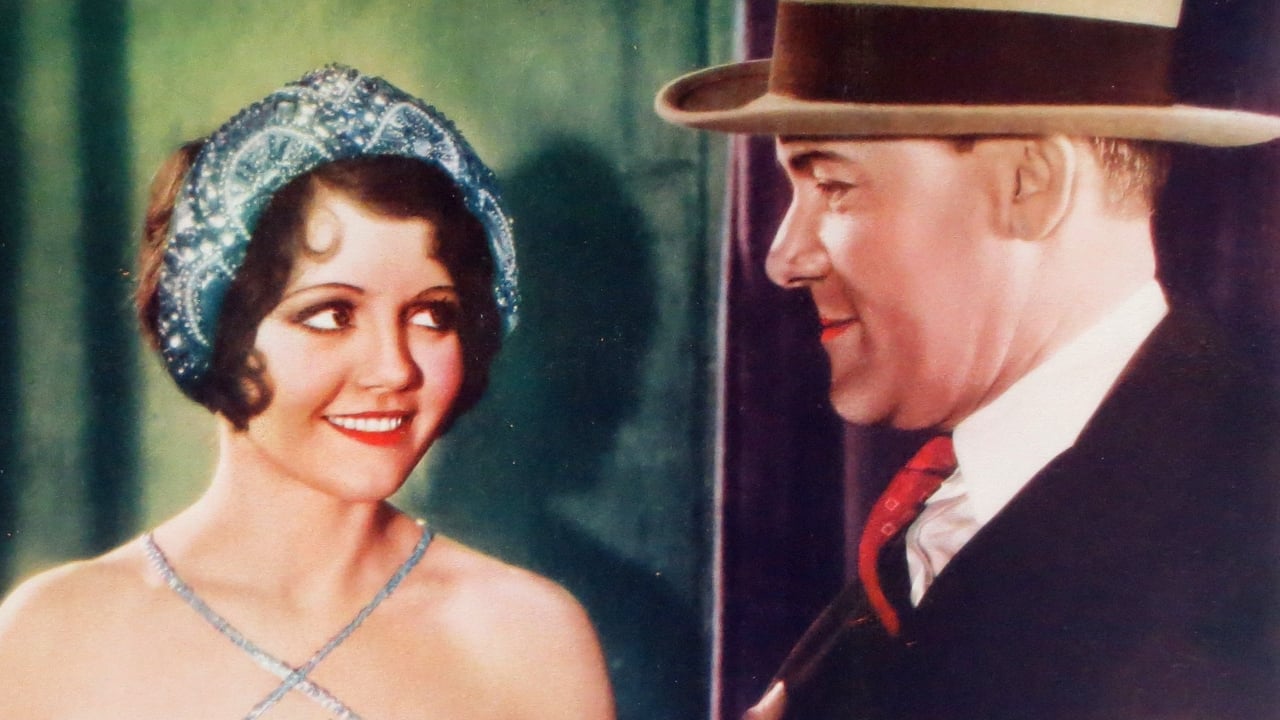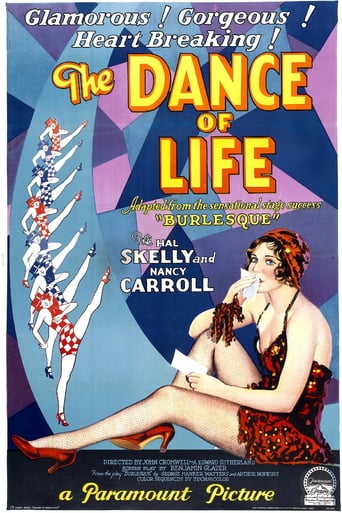



It is not only a funny movie, but it allows a great amount of joy for anyone who watches it.
View MoreYour blood may run cold, but you now find yourself pinioned to the story.
View MoreOne of those movie experiences that is so good it makes you realize you've been grading everything else on a curve.
View MoreBlistering performances.
Back in the early days of sound movies, Hollywood was in love with musical spectaculars. The problem is that with the earliest ones, the quality of the sound and dancing is pretty awful. This is painfully obvious in "The Dance of Life". I don't entirely blame the films. After all, sound technology was primitive and quality choreography was something you wouldn't see until the early 30s. The Busby Berkeley-style song and dance numbers were very crisp and professional--the stuff in the earlier films just looks rough...very rough.This film is about two stage performers--Skid (Hal Skelly), a comedian, and Bonny (Nancy Carroll). When the film begins, both are out of work and struggling. Together, they seem to do much better and come to be friends and eventually marry. However, over time, Skid hits the big time and Bonny is left behind--putting a big strain on their relationship. Eventually, she takes up with a millionaire and Skid, unexpectedly, hits the skids. What's next for the duo?This film is very dated. As I mentioned, the dancing is pretty bad. Additionally, similar material is handled better in other films. Mostly of interest to devoted fans of the real oldies.By the way, sadly only a few years after doing this film, Hal Skelly was killed when he was a passenger in a car that got hit by a train! So, if you ever wanted to see this vaudevillian, this film is one of the few chances.
View MoreThe famous play, BURLESQUE, came to Hollywood following a successful Broadway run (372 performances at the Plymouth Theatre from Sept. 1, 1927 through July of the following year made it one of the biggest hits of the year) just at the cusp of when burlesque - which George Jessel had described as "the most family friendly" theatre form as straight vaudeville declined - was itself declining from the fine mix of sketch comedy and music into the girlie shows that would be banned by Mayor LaGuardia in the 1940's. Paramount apparently felt that decline as well as the universal quality of the story merited the name change to THE DANCE OF LIFE for their August 16, 1929 film release, but they also knew well how famous the original play had become as it toured around the nation, so the original name was prominently featured in all the advertising.Protecting their investment further, four members of the original Broadway cast were recruited for the film version (the lead, Hal Skelly as "Skid", Ralph Theodore as Harvey, Charles D. Brown as Lefty and the great Oscar Levant in his first film role as Jerry the composer/pianist). Only the Broadway leading lady, Barbara Stanwyck as Bonny, Skid's lady love, was passed over for look-alike Nancy Carroll (rumor hath that Stanwyck's real life leading man declined to let her take the role unless he was hired too). Carroll was entirely fine in the role and Stanwyck followed to Hollywood shortly after.The result for THE DANCE OF LIFE was one of the year's best films and the script, direction and cinematography hold up remarkably well after a little over 80 years, much better than some of the early full fledged "musicals" filmed at the time. This was not a traditional "musical" by Broadway or Hollywood standards, but a play in which a lot of music was intrinsic to the plot, and the musical numbers are as good a snapshot of what real live touring musical theatre looked like in 1929 as many an actual filmed musical show (like the Marx Brothers' COCOANUTS which was filmed at the end of its "subway circuit" tour out at the Astoria Studios in Astoria, Queens, New York). The borderline "beef trust" chorus girls marching in unison are a far cry from modern "choreography," but they breathe with the life of the world portrayed.As good as the film is - and it is very good indeed, despite the often copied plot, remarkably faithful to the Broadway original, of the loyal girl protecting her talented but weak partner - no small credit is due to the superior cast. An Oscar Levant younger than most people today know him from his film roles of ten to twenty years later (THE BAND WAGON, opposite Nanette Fabray passing for a composer/lyricist team patterned after Betty Comden and Adolph Green is a classic), gives every indication of the indelible comic curmudgeon he would become, and Hal Skelly's Skid is a leading character actor for the ages. "Skid" would be a great performance in any age.I haven't seen a naturalistic performance jump out of the more declamatory style performances around it with this much vivacity since Helen Hayes opposite Gary Cooper (three years later) in A FAREWELL TO ARMS. Hayes, of course, would go on to a brilliant career on stage and screen for another 50 years. Skelly might have, but after only a few more films and Broadway shows, while back East producing and starring in one of them (the ironically titled COME WHAT MAY) he lost his life when a car he was riding in was hit by a freight train in Connecticut. It was a greater loss to the stage and screen than those who have never seen his performance in this film (BURLESQUE was, with good reason, his greatest hit) can ever fathom.I've never been able to find a copy of the brief VHS release noted elsewhere of the Paramount Picture, but until some wise soul finds a way to pry a pristine copy from the Paramount archives (one suspects the film may now be in the public domain if ANY copy could be found) to make it available to a new generation of film and theatre students who need to see the craft and passion involved, at least a decent copy can be viewed at Archive.org. It is essential viewing for any true student of the theatre or film. I'll be first in line to buy a copy when a DVD is available. Let's hope it's soon.
View MoreOdd title for the film version of the Broadway hit, BURLESQUE, that starred Hal Skelly and Barbra Stanwyck and made them both stars. Odd also that Skelly would topline the 1929 film version but Nancy Carroll would get the lead role over Stanwyck.In any case both stars are excellent in this underrated and forgotten gem that includes great vaudeville numbers, songs, comedy, and drama.Skelly is an "eccentric" dancer who teams with Carroll and they struggle on the burlesque circuit until a talent scout spots Skelly and gets him a spot in the Ziegfeld Follies. But money and fame go to his head and he starts boozing with a golddigging hussy. Eventually he his fired and Carroll sues for divorce to marry a Wyoming rancher. Skelly has one more chance when he's offered his old job with the burlesque show but Carroll must leave Wyoming to help him get through his opening show.Hackneyed plot but done with great spirit and truth. Carroll and Skelly are great. Supporting cast includes May Boley terrific as Gussie, Oscar Levant as a pianist, Al St. John as Bozo, Charles Brown as the burlesque manager, Ralph Theodore as Harvey, and Dorothy Revier as Marco.High point is a terrific semi closeup of Skelly sitting on the stage and singing "True Blue Lou" in his sad clown makeup. Great moment. Carroll gets to do several dances and she's damned good. Her singing isn't as good though.After seeing the lousy HONEY I was skeptical about another Nancy Carroll musical but THE DANCE OF LIFE is terrific. Hal Skelly could have been a big big star but he was hideously killed in 1934 when the car in which he was riding was smashed by a freight train in Connecitcut.
View MoreHere's one of the early talkies that has been readily available to home video, but one I've avoided. An early musical, and yet another "backstage" plotline, this was something I've seen done so poorly elsewhere I suspected I'd wind up throwing things at my TV. [Have any of you anguished your way through the musical numbers of The Great Gabbo?] Happily, such was not the case. Here is a film totally accessible to contemporary audiences.A big film in its time, Paramount popped for Technicolor and assigned it's two top directors, Cromwell and Sutherland. [The directors appear in cameos as doorman and theatre attendant, respectively.] Musical sequences are well done and entertain. Cringe factor on a one to five scale, one. The wonder of seeing the tall, lanky Skelly and diminutive Carroll dancing in perfect unison is still with me. They're the most unlikely team this side of Laurel and Hardy.Many other splendid differences between this film and its contemporaries are worth noting. Released August, 1929, Paramount's superimposed credits seem so much more modern than the silent card graphics MGM still used. Not everyone cares to know who the associated producer is, we want entertained. Behind The Dance Of Life, silhouetted stage hands scurry about, pulling backdrops and riggings. You're treated to seeing behind the scenes while the obligatory texts play out. The ensemble cast has antagonists which prove to be red herrings. It's loaded with interesting camera compositions. A train is gained and quit at night in a pouring rainstorm. A sandwich is used as a romantic device. And what I enjoyed the most was the personal and up close feeling the directors give scenes. Skelly, after pratfalling from wing to wing, sings "True Blue Lou" so personally it would seem he was oblivious to the camera which closed in three times during the song.A snapshot of a lost form of American entertainment, The Dance Of Life stands apart from its roots as a great film. See it!
View More